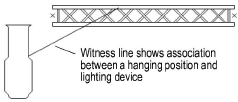 Inserting Hanging Positions
Inserting Hanging Positions
 Inserting Hanging Positions
Inserting Hanging Positions Use the Hanging Position tool to insert a hanging position symbol from the Resource Manager. To import symbols from the libraries included with the Vectorworks Spotlight software, select Vectorworks Libraries from the file browser pane in the Resource Manager, and open the appropriate symbols library. You can also import custom symbols from a Favorites file or use a symbol from the current file. See Concept: Bibliothèques.

To insert a hanging position symbol:
Click the Hanging Position tool from the Spotlight tool set.
Click Position symbol on the Tool bar. From the Resource Selector, double-click a resource to activate it.
Alternatively, from the Resource Manager, either double-click the position symbol to insert or right-click on the position symbol and select Make Active from the context menu. The Hanging Position tool is automatically selected.
Click in the drawing to insert the active hanging position symbol definition, and then click again to set the hanging position rotation.
If a hanging position is accidentally inserted with the Symbol Insertion tool, the position functionality will not be present. When correctly inserted, the Object Info palette displays “Hanging Position” for the selected hanging position.
A different type of hanging position can be placed by changing the active symbol definition and continuing to use the Hanging Position tool.
The hanging position object parameters can be edited from the Object Info palette.
► Cliquez pour afficher/masquer les paramètres.
The Z value of a hanging position can only be specified for hanging positions with 3D geometry. However, the Z value can be specified for the lighting instruments placed on any type of hanging position (2D, 3D, or hybrid). A hanging position created from a symbol or plug-in object automatically assumes the Z value of the original object.
If a hanging position is copied, it is automatically renamed; any associated duplicated lighting instruments are associated with the new hanging position. Deleting a hanging position does not delete the associated lighting instruments.
If instruments are moved to a different hanging position, the hanging position name is automatically updated for the instruments and the Z-height of the instruments is calculated automatically based on the hanging position Z-height.
Objects with load data can be associated with a hanging position. Lighting instruments are associated automatically when Inserting Instruments on a hanging position; however, other objects, considered “loads,” can be associated as well. These include the video screen objects, speakers and speaker arrays, soft goods, hoist, cables, and point and distributed loads.
When a load is associated, or attached, to a hanging position, its height is automatically set correctly. The load moves with the hanging position. The load on the hanging position is also calculated properly (Braceworks required).
A load that is attached to a hanging position can be moved off of the position. A witness line is automatically created to indicate the association; witness lines are classed separately so that they can be displayed or hidden.

To attach an object to a hanging position:
Select the hanging position.
Right-click on the hanging position, and select Attach Loads from the context menu.
The cursor changes to a bull’s eye. Valid load objects that can be associated with the hanging position are highlighted as the cursor moves over them.
Click to attach the load to the hanging position.
A witness line is created from the hanging point on the hanging position to the insertion point on the load. The control point on the witness line can be moved to change its location. The load can be moved directly onto the hanging position (removing the witness line) by selecting Move to Hanging Point.

Load objects can be removed from their association with a hanging position.
To disassociate a load object from its hanging position:
Select the load object.
From the load drop-down context menu, select Remove from Hanging Position.
Alternatively, remove the load by selecting the hanging position.
Select the hanging position.
Right-click on the hanging position, and select Remove Loads from the context menu.
The cursor changes to a bull’s eye. Valid load objects that can be disassociated from the hanging position are highlighted as the cursor moves over them.
Click to detach the load from the hanging position.
~~~~~~~~~~~~~~~~~~~~~~~~~